You’ll survive long VR gaming sessions by optimizing your headset fit and adjusting IPD settings for comfort, maintaining room temperature at 65-68°F with proper ventilation, and investing in ergonomic head straps for better weight distribution. Set up anti-fatigue mats for cushioning, establish 20-20-20 break schedules to combat eye strain, and use extended battery solutions like charging straps. Keep snacks prepared, practice relaxation techniques between sessions, and guarantee proper lighting to reduce visual strain for maximum endurance and comfort during extended gameplay.
Optimize Your Room Temperature and Ventilation
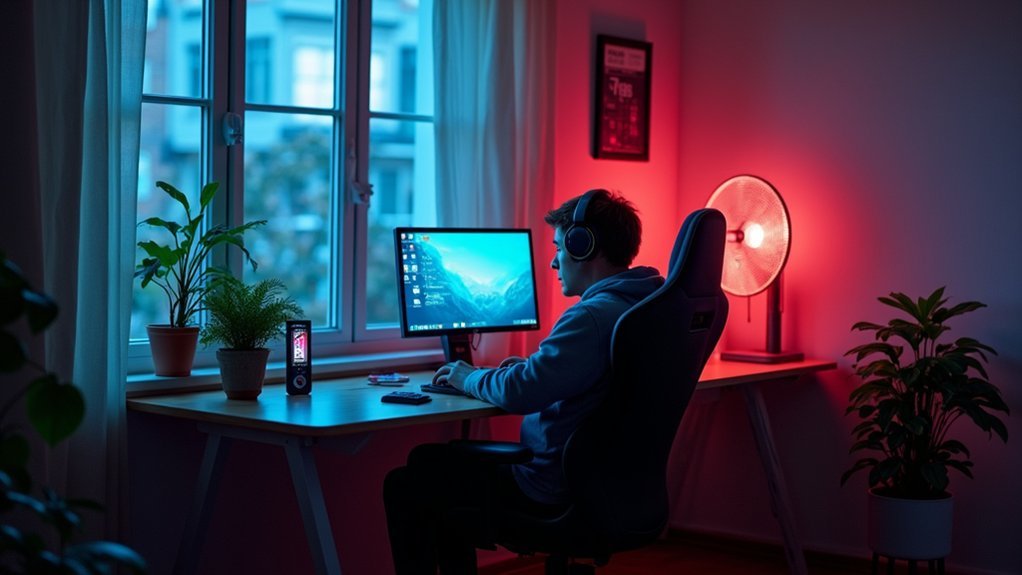
While VR headsets generate considerable heat during operation, you can greatly improve your comfort by maintaining your gaming room at 65-68°F (18-20°C).
This cooler room temperature notably reduces sweat and heat buildup during extended gaming sessions.
Ensure proper ventilation through air conditioning or open windows to create steady airflow. Good ventilation prevents overheating and maintains consistent thermal comfort throughout your play area.
Monitor temperature levels regularly and adjust airflow as needed.
Take scheduled breaks every 30-60 minutes to step away from your VR space and cool down in a designated seating area.
During these breaks, you’ll allow your body temperature to normalize while the room’s ventilation system continues working to maintain ideal conditions for your next session.
Invest in Proper Head Straps and Weight Distribution
Beyond environmental comfort, your headset’s physical fit plays an equally important role in marathon VR sessions. Poor weight distribution creates pressure points that’ll turn your gaming adventure into an endurance test. Investing in quality head straps transforms your comfort level dramatically.
Proper head straps like the Globular Cluster redistribute weight evenly across your head, eliminating painful pressure points that cause fatigue. Battery straps such as the Bobo S3 provide counterbalance, reducing neck strain during extended play. Most importantly, stable headsets prevent unnecessary movement that triggers motion sickness.
- Choose adjustable straps that conform to your unique head shape
- Look for padding that distributes pressure evenly across contact points
- Consider battery-integrated straps for improved weight balance
- Guarantee secure fit without over-tightening
- Test stability during active gameplay movements
Set Up Effective Charging Solutions and Power Management
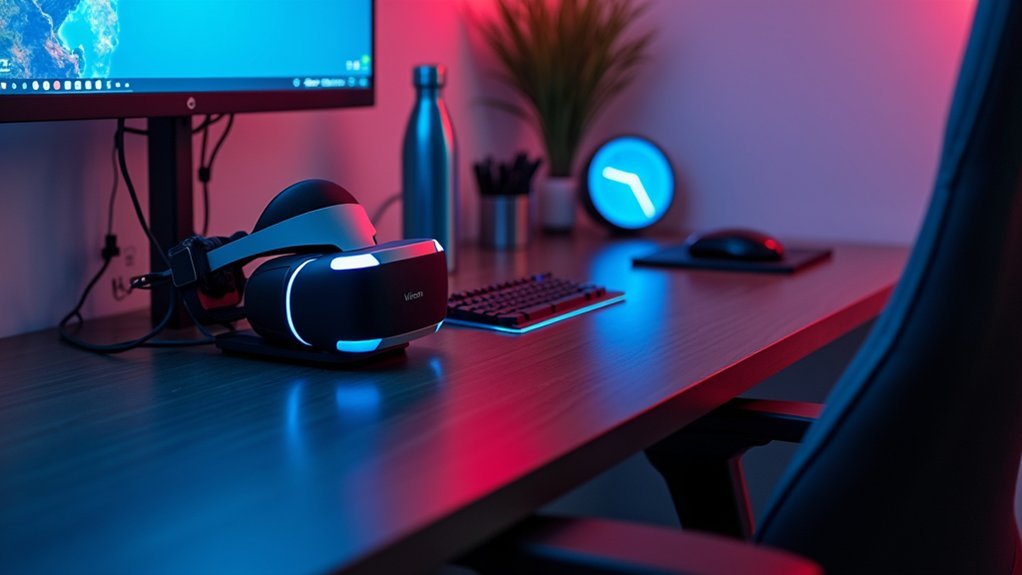
Nothing kills immersion faster than a dead headset battery mid-session. Effective charging solutions and power management are essential for surviving long VR sessions without interruption.
Use long, braided USB-C cables that let you shift seamlessly between seated and standing play. Magnetic adapters make quick charging effortless while seated, eliminating cumbersome cable management around your headset.
Battery straps like the Bobo S3 integrate additional power directly into your setup, extending playtime considerably. External battery packs offer another smart charging solution that reduces setup time and manages power efficiently.
Keep extra trackers ready to replace any that lose power during gameplay. This prevents frustrating interruptions and maintains your gaming flow.
With proper power management strategies, you’ll never have to cut sessions short due to dead batteries again.
Create a Comfortable Play Area With Proper Flooring
Since your feet bear the brunt of extended VR sessions, investing in proper flooring transforms comfort levels dramatically.
Anti-fatigue mats provide essential cushioning that reduces joint pressure during prolonged exposure to standing gameplay. You’ll want comfortable flooring that supports natural movement while maintaining safety standards.
Your ideal VR setup should include:
- Thick exercise mats or specialized anti-fatigue mats for maximum cushioning
- Non-slip surfaces like textured rugs to prevent dangerous falls during movement
- Soft materials such as foam padding to alleviate pressure on feet and legs
- Proper ventilation around your play area to prevent overheating on padded surfaces
- Strategic placement of flooring that covers your entire movement range
This foundation keeps you comfortable and safe throughout marathon gaming sessions.
Establish Regular Break Schedules to Combat Cybersickness
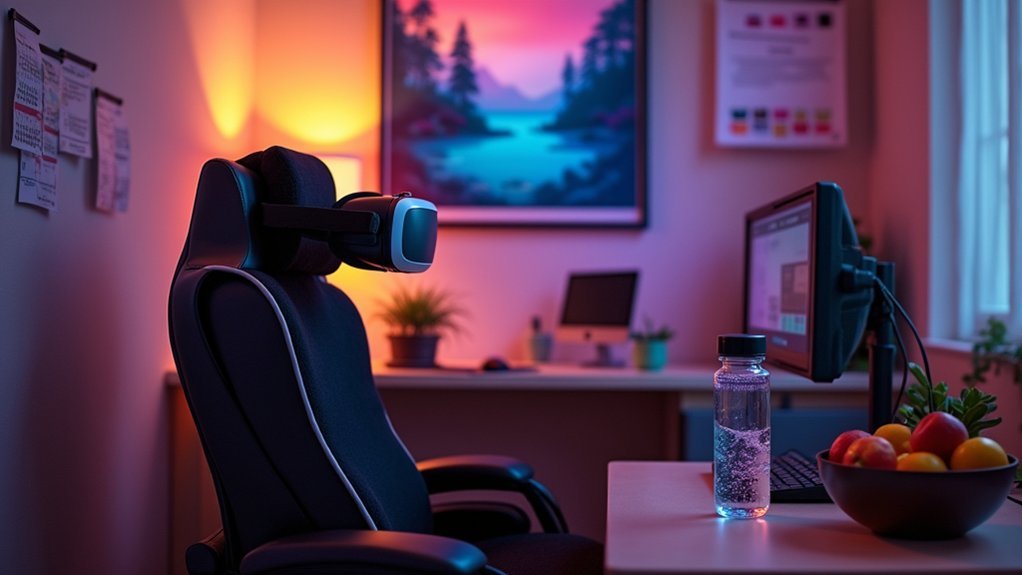
You’ll need to build regular breaks into your VR gaming routine to prevent cybersickness from ruining your extended sessions.
Start by implementing the 20-20-20 rule: every 20 minutes, take a 20-second break to focus on something 20 feet away.
Beyond this eye-relief technique, you should schedule mandatory rest periods every 30-60 minutes to give your entire system time to reset.
Implement 20-20-20 Rule
When you’re deep into an immersive VR world, it’s easy to lose track of time and push through mounting discomfort. However, implementing the 20-20-20 rule can dramatically improve your gaming endurance.
This simple technique involves taking a 20-second break every 20 minutes to look at something 20 feet away, effectively resetting your visual focus and reducing eye strain.
Since up to 95% of VR users experience motion sickness, these regular breaks become essential for maintaining comfort during extended sessions.
- Set a timer for every 20 minutes to guarantee consistent adherence
- Remove your headset completely and focus on distant objects
- Use break time for light stretching to improve circulation
- Allow your eyes to readjust to natural lighting conditions
- Gradually increase session length as your tolerance improves
Schedule Mandatory Rest Periods
Beyond implementing the 20-20-20 rule for eye relief, you need to establish mandatory rest periods every 30-60 minutes to prevent cybersickness from derailing your gaming marathon.
Research shows new VR users often experience significant cybersickness after just 30 minutes of gameplay, making these mandatory breaks vital for comfort and adaptation.
When you schedule these rest periods, use the time to stretch, hydrate, and reset your focus.
This approach helps mitigate common VR symptoms while allowing your body to adjust to virtual environments. You can gradually increase your gameplay duration as tolerance builds, but don’t skip the breaks.
Use these intervals to check your equipment setup and verify everything’s functioning smoothly, reducing motion sickness risks during extended sessions.
Stay Hydrated and Keep Snacks Within Reach
Your body needs consistent fuel and hydration to maintain peak performance during extended VR sessions.
You’ll want to drink at least 8 ounces of water every hour and keep energy-sustaining snacks like nuts, protein bars, or whole-grain crackers within arm’s reach.
Setting up a designated snack and hydration station near your gaming area prevents lengthy interruptions while keeping your energy levels stable throughout your virtual adventures.
Hydration During VR Sessions
While you’re immersed in virtual worlds, your body’s need for hydration doesn’t pause. Dehydration can quickly lead to fatigue and decreased focus, greatly impacting your VR sessions and overall gameplay performance.
Regular hydration breaks are essential for maintaining ideal energy levels throughout extended gaming periods.
Keep these hydration strategies in mind:
- Position a water bottle within arm’s reach to encourage consistent drinking
- Set reminders to hydrate every 30-60 minutes during gameplay
- Choose water over sugary drinks to avoid energy crashes
- Take brief breaks between intense gaming sequences to rehydrate
- Monitor your body’s signals – headaches or dizziness indicate dehydration
Studies show that players who maintain proper hydration experience markedly less fatigue and discomfort, enabling longer and more enjoyable gaming sessions without compromising performance or comfort.
Energy-Sustaining Snack Choices
As your body burns energy traversing virtual environments, strategic snacking becomes essential for maintaining peak performance during extended VR sessions.
You’ll want to choose protein-rich options like nuts or yogurt that provide sustained fuel and stabilize blood sugar levels. Complex carbohydrates such as whole-grain crackers or fresh fruit offer lasting energy without dramatic spikes and crashes that compromise your comfort.
Prepare small portions beforehand and keep snacks easily accessible within your gaming area to minimize interruptions. This preparation guarantees you’ll maintain steady energy levels while staying focused on your virtual adventures.
Avoid excessive caffeine and sugary treats that lead to energy crashes. Remember to stay hydrated alongside your snacking strategy, as proper nutrition and fluid intake work together to optimize your VR gaming endurance and overall performance.
Adjust Headset Fit for Optimal Comfort and Stability
A poorly fitted VR headset transforms what should be an immersive gaming adventure into an uncomfortable ordeal marked by pressure points, slipping displays, and constant readjustments.
Proper headset fit maximizes comfort during extended VR sessions through strategic weight distribution that prevents fatigue. You’ll dramatically reduce eye strain by adjusting your interpupillary distance settings to align lenses perfectly with your eyes.
- Check headstrap tension before each session to guarantee snug but comfortable positioning
- Adjust IPD settings to match your eye spacing for crystal-clear visuals
- Consider upgrading to enhanced headstraps like the Globular Cluster for better stability
- Position foam padding to eliminate pressure points around your face
- Clean lenses and padding regularly to maintain hygiene and prevent skin irritation
Use Anti-Fatigue Mats and Ergonomic Accessories
Beyond securing your headset properly, your feet and body need equal attention during marathon VR sessions. Anti-fatigue mats provide essential cushioning that reduces discomfort while promoting better circulation and posture during extended standing.
Anti-fatigue mats deliver immediate relief by evenly distributing pressure across your feet during extended VR sessions.
You’ll notice the difference immediately as these mats distribute pressure evenly across your feet.
Ergonomic accessories like adjustable headstraps and battery packs redistribute your headset’s weight, preventing neck strain that typically builds up after hours of play.
Don’t overlook supportive footwear either – proper shoes enhance stability and reduce injury risk during intense immersive experiences.
Consider adding exercise mats or cushioned flooring to your play area for joint protection.
Combined with regular breaks, these comfort upgrades can extend your gaming sessions from 2-3 hours to 4+ hours comfortably.
Maintain Proper Lighting and Reduce Visual Strain
While your physical comfort matters tremendously, your eyes bear the greatest burden during extended VR sessions. Proper lighting management becomes critical for preventing eye strain and maintaining focus throughout lengthy gameplay.
You’ll want to optimize your environment to reduce visual fatigue that accumulates during immersive experiences.
- Position soft LED lighting behind your play area to eliminate harsh shadows and create ambient illumination
- Adjust your headset’s screen brightness and contrast settings to comfortable levels that don’t overwhelm your vision
- Avoid direct ceiling light glare by repositioning overhead fixtures or using diffused lighting sources
- Implement a strict break schedule following the 20-20-20 rule: every 20 minutes, look at something 20 feet away for 20 seconds
- Keep your VR headset clean to prevent additional visual strain from smudged lenses
Practice Relaxation Techniques Between Gaming Sessions
Extended VR gaming sessions can leave your mind racing and muscles tense, making it essential to incorporate deliberate relaxation techniques between gameplay periods.
Deep breathing exercises effectively reduce stress and anxiety while helping you maintain focus for your next session. Try inhaling slowly for four counts, holding briefly, then exhaling for six counts.
Progressive muscle relaxation works by systematically tensing and releasing different muscle groups, alleviating physical tension accumulated during extended play. Start with your feet and work upward through your body.
Practice mindfulness meditation for just a few minutes to enhance mental clarity and promote calm.
Additionally, establish a routine of stretching between sessions to prevent stiffness and boost performance when you return to your virtual world.
Frequently Asked Questions
How Long Should a VR Session Last?
You should start with five-minute VR sessions, then gradually increase to ten minutes after a week, and fifteen minutes by the third week. Don’t exceed thirty minutes initially to avoid motion sickness.
How Many Hours a Day Should I Play VR?
You shouldn’t exceed 2-3 hours daily when starting VR gaming. After building tolerance, you can play up to 6 hours with proper breaks every 30-60 minutes to prevent fatigue and motion sickness.
How Long Is OK to Stay on VR?
You should start with 5-minute sessions, gradually increasing to 15 minutes over three weeks. Most users experience discomfort after 30 minutes, so you’ll need regular breaks for comfort.
What Happens if You Play VR for 2 Hours?
You’ll likely experience significant cybersickness symptoms like nausea and dizziness, especially if you’re new to VR. Expect peak discomfort around 30 minutes, with recovery taking about 11 minutes after removal.


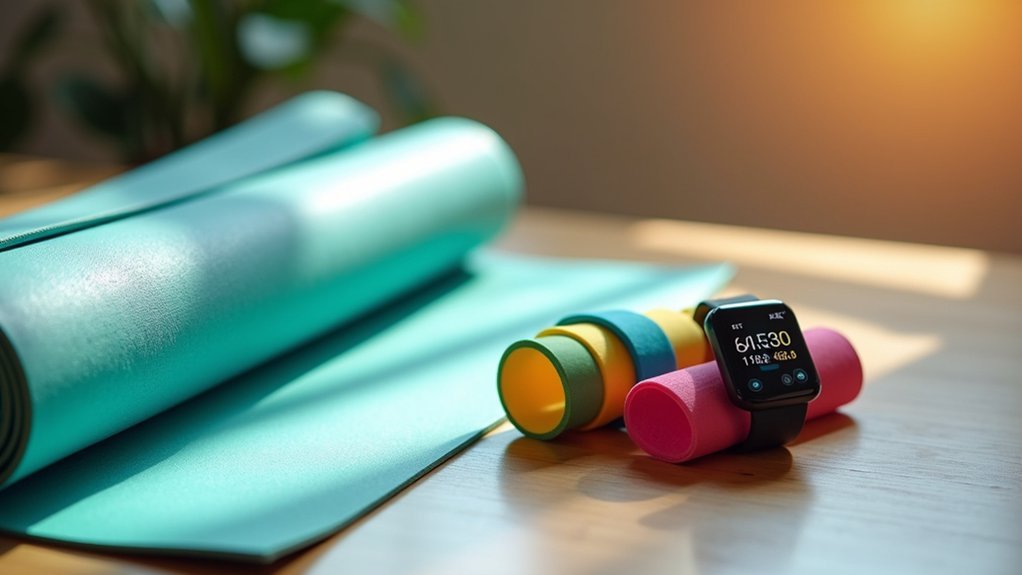
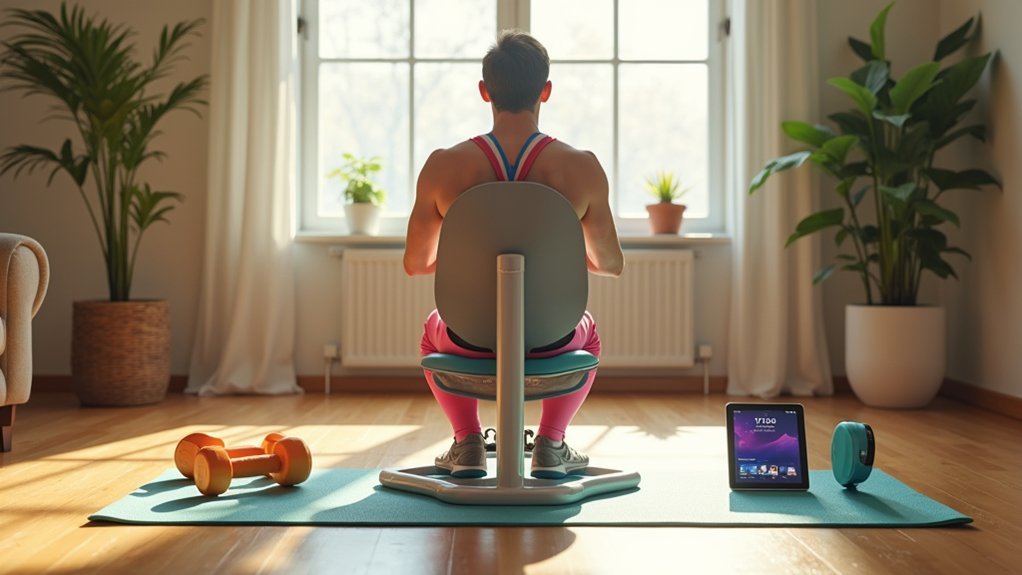

Leave a Reply